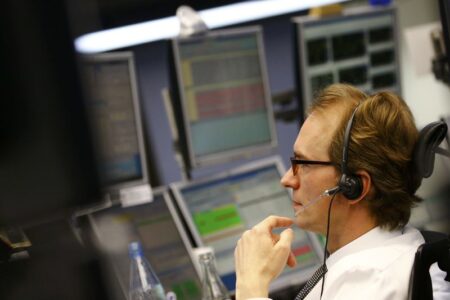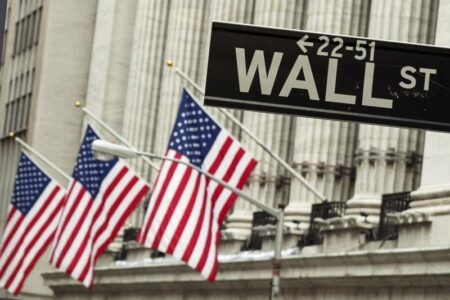By Wayne Cole
SYDNEY (Reuters) -Share markets tumbled and bonds rallied in Asia on Monday as fears the United States could be heading for recession sent investors rushing from risk assets while wagering that rapid fire rate cuts will be needed to rescue growth.
The safe haven yen and Swiss franc surged as crowded carry trades unravelled, sparking speculation some investors were having to unload profitable trades just to get the money to cover losses elsewhere. Such was the torrent of selling that circuit breakers were triggered in exchanges across Asia. [FRX/]
Nasdaq futures sank a deep 3.7%, while dropped 1.8%. EUROSTOXX 50 futures fell 1.3% and 0.8%.
shed a gut-wrenching 11.6% to hit seven-month lows, a scale of losses not seen since the 2011 global financial crisis. MSCI’s broadest index of Asia-Pacific shares outside Japan lost 3.8%.
Chinese blue chips dipped only 0.5%, aided by a bounce in the Caixin services PMI to 52.1.
Japanese yields fell a steep 17 basis points to the lowest since April at 0.785%, as markets radically reconsidered the prospect of another hike from the Bank of Japan.
Treasury bonds were in demand with 10-year yields hitting 3.723%, the lowest since mid-2023.
Two-year yields dropped to 3.807%, having already fallen 50 basis points last week, and could soon slide below 10-year yields, turning the curve positive in a way that has heralded recessions in the past.
The worryingly weak July payrolls report saw markets price in a 78% chance the Federal Reserve will not only cut rates in September, but ease by a full 50 basis points. Futures imply 122 basis points of cuts in the 5.25-5.5% funds rate this year, and see rates around 3.0% by the end of 2025.
“We have increased our 12-month recession odds by 10pp to 25%,” said analysts at Goldman Sachs in a note, though they thought the danger was limited by the sheer scope the Fed had to ease policy.
Goldman now expects quarter-point cuts in September, November, and December.
“The premise of our forecast is that job growth will recover in August and the FOMC will judge 25bp cuts a sufficient response to any downside risks,” they added. “If we are wrong and the August employment report is as weak as the July report, then a 50bp cut would be likely in September.”
Analysts at JPMorgan were even more bearish, subscribing a 50% probability to a U.S. recession.
“Now that the Fed looks to be materially behind the curve, we expect a 50bp cut at the September meeting, followed by another 50bp cut in November,” said economist Michael Feroli.
“Indeed, a case could be made for an inter-meeting easing, especially if the data soften further — although Fed officials might worry about how such a move could be (mis)interpreted.”
SEEKING SAFE HARBOURS
Investors will get a read on employment in the service sector from the ISM non-manufacturing survey due later Monday and analysts are hoping for a rebound to 51.0 after June’s unexpected slide to 48.8.
This week has earnings from industrial bellwether Caterpillar (NYSE:) and media giant Walt Disney (NYSE:), which will give more insight into the state of the consumer and manufacturing. Also reporting are healthcare heavyweights such as weight-loss drugmaker Eli Lilly (NYSE:).
The huge drop in Treasury yields had also overshadowed the U.S. dollar’s usual safe-haven appeal and dragged the currency down 0.4% on a basket of majors.
The dollar shed another 2.2% on the Japanese yen at 143.10, while the euro dived 1.9% to 156.35. The single currency was holding firm on the dollar at $1.0934. [USD/]
The Swiss franc was a major beneficiary of the rush from risk, with the dollar falling 0.9% to touch six-month lows at 0.8485 francs.
“The shift in expected interest rate differentials against the U.S. has outweighed the deterioration in risk sentiment,” said Jonas Goltermann, deputy chief markets economist at Capital Economics.
“If the recession narrative takes hold in earnest, we would expect that to change, and the dollar to rebound as safe-haven demand becomes the dominant driver in currency markets.”
Investors had also increased wagers other major central banks would follow the Fed’s lead and ease more aggressively, with the European Central Bank now seen cutting by 67 basis points by Christmas.
In commodity markets, gold gained a safety bid and rose to $2,456 an ounce. [GOL/]
Oil prices started firmer amid concerns about a widening conflict in the Middle East, but worries about global demand soon dragged it down again. [O/R]
slipped 13 cents to $76.68 a barrel, while lost 22 cents to $73.30 per barrel.
Read the full article here
















